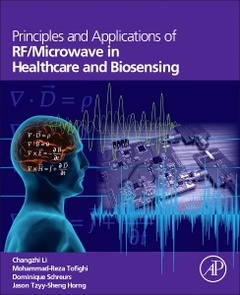Description
Principles and Applications of RF/Microwave in Healthcare and Biosensing
Authors: Li Changzhi, Tofighi Mohammad-Reza, Schreurs Dominique, Horng Tzyy-Sheng Jason
Language: English
Subjects for Principles and Applications of RF/Microwave in...:
123.56 €
In Print (Delivery period: 14 days).
Add to cart342 p. · 19x23.3 cm · Hardback
Description
/li>Contents
/li>Readership
/li>Biography
/li>Comment
/li>
This reference, written by leading authorities in the field, gives basic theory, implementation details, advanced research, and applications of RF and microwave in healthcare and biosensing. It first provides a solid understanding of the fundamentals with coverage of the basics of microwave engineering and the interaction between electromagnetic waves and biomaterials. It then presents the state-of-the-art development in microwave biosensing, implantable devices -including applications of microwave technology for sensing biological tissues ? and medical diagnosis, along with applications involving remote patient monitoring. this book is an ideal reference for RF and microwave engineer working on, or thinking of working on, the applications of RF and Microwave technology in medicine and biology.
Learn:
- The fundamentals of RF and microwave engineering in healthcare and biosensing
- How to combine biological and medical aspects of the field with underlying engineering concepts
- How to implement microwave biosensing for material characterization and cancer diagnosis
- Applications and functioning of wireless implantable biomedical devices and microwave non-contact biomedical radars
- How to combine devices, systems, and methods for new practical applications
1. Fundamentals of microwave engineering2. Interaction between electromagnetic waves and biological materials3. Microwave cancer diagnosis4. Wireless closed-loop stimulation systems for symptom management5. Human-aware localization using linear-frequency-modulated continuous-wave radars6. Biomedical radars for monitoring health7. RF/wireless indoor activity classification
Microwave engineers and researchers, microwave application engineers, graduate and undergraduate students of engineering and medicine.
Mohammad-Reza Tofighi received a B.S. degree from Sharif University of Technology, Iran, in 1989, an M.S. degree from Iran University of Science and Technology, in 1993, and a Ph.D. degree from Drexel University, Philadelphia, PA, in 2001, all in electrical engineering. He is now an Associate Professor of Electrical Engineering at Pennsylvania State University, Harrisburg. His main research interest is on medical and biological applications of RF and microwave, which he has been pursuing for the past eighteen years. In particular, he conducts research on wireless implants and sensors, microwave radiometry and imaging, biomedical antennas and applicators, interaction of microwave with biological tissues, and permittivity measurement using time and frequency domain methods. Dr. Tofighi has been the past chair (2009-2013) of the MTT-10, the technical committee on biological effects and medical applications of RF and microwave of the IEEE Microwave Theory and Techniques (MTT) society. For many years, he has been active in promoting the subject area of medical and biological applications of RF and Microwave with
- The first book to review the fundamentals, latest developments, and future trends in this important emerging field with emphasis on engineering aspects of sensing, monitoring, and diagnosis using RF and Microwave
- Extensive coverage of biosensing applications are included
- Written by leaders in the field, including members of the Technical Coordinating Committee of the Biological Effects and Medical Applications of the IEEE Microwave Theory and Techniques Society



